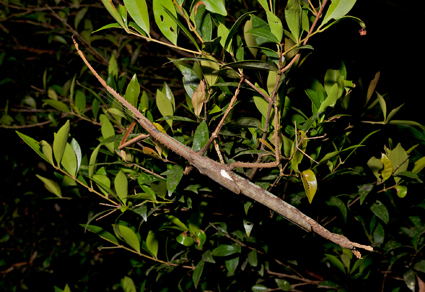A new species of giant stick insect has been discovered in the tropical rainforests of Far North Queensland, Australia. Scientists believe this newly identified insect, named Acrophylla Alta, could be the heaviest insect in Australia, weighing up to 44 grams.

Discovery in High-Altitude Rainforest
The insect was found living in high-altitude forests of the Atherton Tablelands, in an area above 900 metres. The species name alta comes from the Latin word for "high", showing the insect’s connection to the elevated forest canopy. According to the researchers, this area is part of the Wet Tropics World Heritage Area, a region rich in unique plants and animals.
The discovery began with a photograph sent to researchers. Naturalist Angus Emmott and scientist Ross Coupland searched for the insect after seeing the image. They later found a large female between Millaa Millaa and Mount Hypipamee. “We looked at its eggs after it laid some eggs and we were absolutely certain it was a new species,” said Mr. Emmott.
Is this the Heaviest Insect in Australia?
Only two females of Acrophylla Alta have been found so far. One of them was discovered in a garden by a friend of Mr. Emmott. The insect was photographed and weighed before being released. It reached 44 grams, making it possibly the heaviest insect recorded in Australia.
“I know the large burrowing cockroach was considered the heaviest insect, but it only gets into the mid-30 grams,” Mr. Emmott explained.
The scientists published their findings in the journal Zootaxa. However, they are still searching for a male of the species, which has not yet been seen. Males might live higher up in the forest canopy, making them even harder to find.
Hard to Study, Easy to Lose
Because Acrophylla Alta lives high in the trees, it is very difficult to study. Mr. Emmott explained, “They live in high-altitude forest, high in the canopy, and unless a bird knocks one down or you get a cyclone or a storm that knocks one down we just can't find them up there in the canopy.”
This situation shows how little is known about insects that live in forest canopies. Many of them might remain unknown to science. As Mr. Emmott said, “In the world of invertebrates there is so much that we don't know yet and so many that are yet to be described.”
Forests Under Threat
Professor Peter Valentine, who was once the chair of the Wet Tropics Management Authority, said that many more species might be living in the canopy. “Canopies are not well studied so there's a chance there are many more species in the canopy than we can even imagine,” he said.
He also added that the discovery shows the need to protect rainforest areas. In particular, invasive species like the yellow crazy ant are a major threat. A program to remove these ants is waiting for federal funding to continue after next year.
“Most of the invasive species which are a real concern to the wet tropics and other natural environments in north Queensland didn't get introduced deliberately to this area,” Mr. Valentine said. They are part of a failed biosecurity regime that we have had as a nation.”
Why This Discovery Matters
More research is needed to understand Acrophylla alta and its role in the ecosystem. Scientists want to learn where the insect lives, how many there are, and what it eats. This will help in making plans to protect the species and its forest home.
“It would be very good just to know how abundant they are and exactly where they occur because that will help us in conserving them,” said Mr. Emmott.
The discovery of this giant stick insect is exciting, but it is also a warning. As Mr. Emmott pointed out, “The scary thing is we may be losing species before we even know they exist.”
